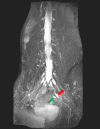Post-Shingrix Vaccination Guillain-Barré Syndrome Presentation in the Emergency Department: A Case Report and Literature Review
- PMID: 39981465
- PMCID: PMC11841657
- DOI: 10.7759/cureus.77777
Post-Shingrix Vaccination Guillain-Barré Syndrome Presentation in the Emergency Department: A Case Report and Literature Review
Abstract
Guillain-Barré syndrome (GBS) is a rare neurological disorder of the peripheral nervous system. We present a case of 65-year-old female patient who developed GBS post-Shingrix inoculation. The patient, with no recognised GBS risk factors, presented with acute bilateral ascending lower limb peripheral nerve pathology eight days post-Shingrix vaccination. Other than abnormal lower limb neurological findings, her examination and biochemical results were normal. Imaging indicated possible inflammation in bilateral lumbosacral plexus. Treatment with IVIG achieved some symptom improvement, but she did not return to her baseline. Functionally, she was able to stand and mobilise 50 metres with a four-wheeled walker. Our case report highlights the importance of considering this syndrome as a differential in patients with no common GBS risk factors post-Shingrix vaccination, despite the large gap in the literature. Further studies into vaccine components as autoimmune triggers are necessary to minimise risk of GBS in the post-vaccination period.
Keywords: autoimmune; case report; guillain-barre syndrome; shingrix; vaccine; varicella-zoster.
Copyright © 2025, Drmota et al.
Conflict of interest statement
Human subjects: Consent for treatment and open access publication was obtained or waived by all participants in this study. Conflicts of interest: In compliance with the ICMJE uniform disclosure form, all authors declare the following: Payment/services info: All authors have declared that no financial support was received from any organization for the submitted work. Financial relationships: All authors have declared that they have no financial relationships at present or within the previous three years with any organizations that might have an interest in the submitted work. Other relationships: All authors have declared that there are no other relationships or activities that could appear to have influenced the submitted work.
Figures


References
-
- European Academy of Neurology/Peripheral Nerve Society Guideline on diagnosis and treatment of Guillain-Barré syndrome. van Doorn PA, Van den Bergh PY, Hadden RD, et al. Eur J Neurol. 2023;30:3646–3674. - PubMed
-
- Guillain-Barre syndrome following oral polio vaccination. Naeem S, Shabbir A, Khan AS, Ahmad S, Mustafa KJ, Fahim A. J Neurovirol. 2016;22:546–549. - PubMed
Publication types
LinkOut - more resources
Full Text Sources
Miscellaneous
